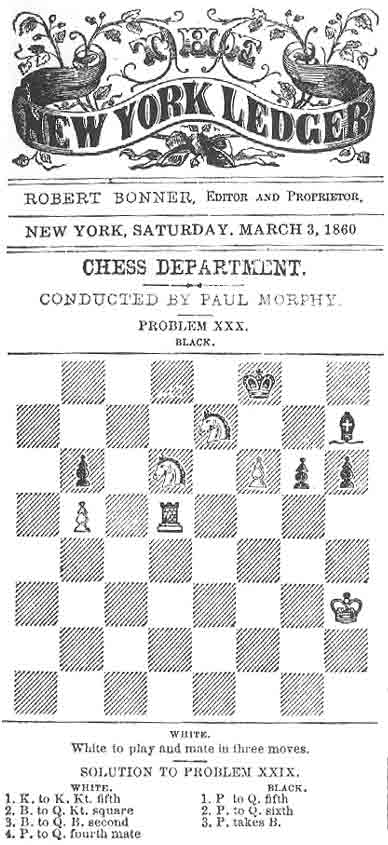Shortly after Morphy's arrival in
New York, W. J. A. Fuller, acting as an agent for publisher, Robert Bonner,
offered Paul an advance of $3,000 to do a weekly chess column for Bonner's
popular weekly paper, the New York Ledger - an offer Morphy readily
accepted:
St. Nicholas Hotel, May 27, 1859
Robert Bonner, Esq., --
Dear Sir: The offer you made to me to edit a
Chess Department in the New York Ledger is so exceedingly liberal
that I do not feel at liberty to decline it. I will commence my
contributions sometime during the month of June next, and shall furnish
chess matter at no other newspaper.
Truly yours,
Paul Morphy.
Although Morphy promised the first installment in June, July was almost
over with no Morphy contribution. Paul was overwhelmed with his public
engagements. During that time he had dined with ex-governor Walker in
Hoboken; attended a dinner at the Athenaeum Cub on 5th Ave. with
Sen. Douglas, Col. Fourney, John Brougham, Rev. Milburn and Park Benjamin;
and later met with Sen. Benjamin at the New York Hotel. He had played a 6 game non-official match with Theodore
Lichtenhein. He sat for a portrait by Charles Loring Elliot (which hung in
the Manhattan Chess club for over 100 years). He was featured in Ballau's
Pictorial the cover of which featured a
sketch of Morphy by Winslow
Homer. Meanwhile, he had taken ill, a condition for which he did spent
some time at the Ocean House at Newport in the White Mountain in August.

Ocean House Hotel in Newport, Rhode Island, founded in 1840, was one of
the largest hotels in this exclusive resort town.
Morphy met Mrs. Butt at the hotel and engaged her daughter, Virginia, in
some games of chess.
Morphy's first column appeared in the August 6, 1859 edition. Although he
ended his affiliation with the Ledger in August, 1860, during that time he
annotated 35 Bourdonnais-M'Donnell games as well as a few of his own and
others. In spite of this, Fuller later referred to Morphy as
"incorrigibly lazy."
(click picture for full page)

|
1859 New York had it's share of newspapers. The New York Times
had been founded in 1851 by George Jones.
The New York Tribune
had been founded by Horace Greeley in 1841.
James Gordon Bennett first published the
New York Herald in 1835.
Alexander Hamilton had established
the Evening Post in 1801.
According to the Handbook of the United States, c 1891:
The New York Ledger, one of the most successful of American
periodicals, was founded in 1856 by Robert Bonner, the father of its present
editors and proprietors. Its success was due entirely to the originality and
enterprise of its founders. Nothing like it was known before, and the
methods pursued in its production and distribution were equally new. The
best writers were engaged, an unexampled rates of compensation, and the
paper was advertised on a scale altogether without precedent. A new industry
was created to distribute it to the public; and the system of news agencies,
then in its infancy, sprang up at once into its full growth. The success
then initiated has been maintained. There is the same splendid liberality in
procuring the best contribution from the most popular writers, and placing
them in an attractive form before the public.
New York Ledger facts:
The New York Ledger
Issues & Index Sources
20-Jan-1847 - 1855, as The Merchant's Ledger
1855 - 1898, as The New York Ledger
1898 - 7-Dec-1903, as The Ledger Monthly
Publishers
1847 - 1851: D. Anson Pratt
1851 - 1886: Robert Bonner
1887 - 1901: Robert Bonner's sons
1901 - 1903: Ledger Company
Editors
1847 - 1851: D. Anson Pratt
1851 - 1887: Robert Bonner
1887 - 1894: Mayo Heseltine
1894 - 1901: Robert Bonner, Jr.
Formats
large tabloid story-paper (22" x 14")
Page counts
4pp at outset, then 8pp
Frequency
1846 - 1847: daily
1847 - 1898: weekly
1898 - 1903: monthly
Robert Bonner, an Irish immigrant, had bought the failing
Merchant's Ledger and Statistical Record for $900 at the end of
1850. After modifying its format to that of the successful London Journal,
he changed its name to the New York Ledger in 1855 and
gradually began introducing literary content.
Bonner didn't mind paying for quality and he published works by such
people as Horace Greeley, Henry W. Longfellow, Charles Dickens and Lord
Alfred Tennyson. Even with such exclusive content, the Ledger
was comparatively cheap, with an annual subscription costing only $2.00 ( or
4 cents per copy). But where he succeeded was in outselling his competitors
by between 400,000, 300,000 copies each week. Robert Bonner became "one of
the richest and most famous men in the United States."
The New York Ledger, while a premier paper in its day, has
been largely forgotten about.
|

